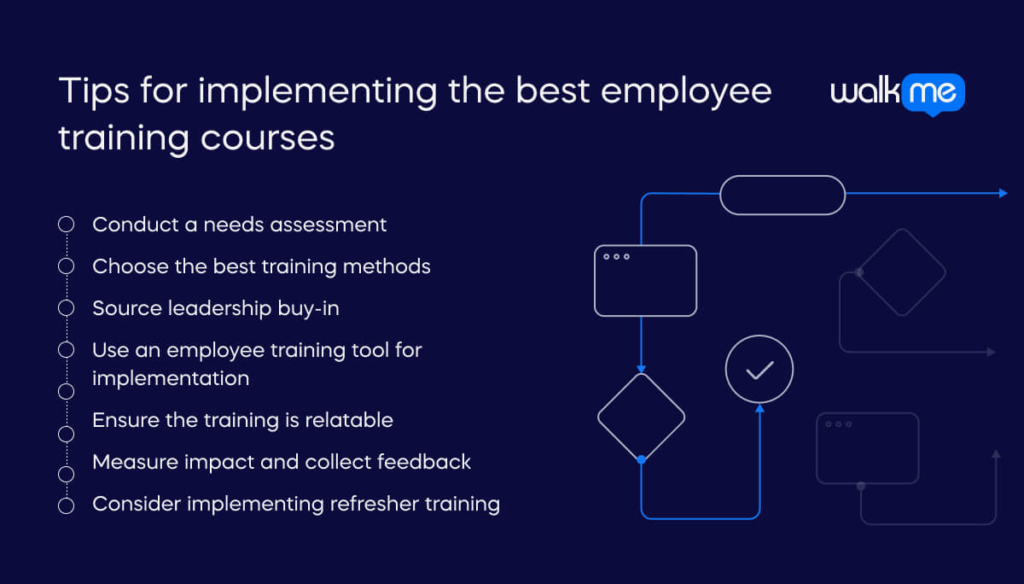Employee training is a vital part of human resource management. It gives employees the skills, knowledge, and resources they need. Employee training courses help new hires gain essential skills. They also allow existing employees to fine-tune their abilities.

These courses aim to improve work performance, increase productivity, and boost employee morale. They also drive organizational growth and success. Effective training courses also help organizations follow legal requirements and industry best practices.
This guide defines employee training courses and highlights the 21 most important types. We will also provide examples and offer tips for implementation.
What are employee training courses?
Companies need training courses to enhance their employees’ skills, knowledge, and performance. These programs cater to specific organizational and individual development needs. It can cover technical skill enhancement, time management training, and soft skills development.
These courses give employees the essential tools and competencies to perform their roles. It can also help them adapt to new technologies and methodologies and contribute to the organization’s growth and success.
21 types of employee training courses
Here are the 21 most popular employee training courses you can put in place at your organization:
1. Communications training
Many employees find talking to managers and coworkers daunting. They might fear looking silly or not knowing how to answer questions. However, training in clear communication can boost confidence and improve performance.
Having communication and presentation skills training has various benefits. These include more confidence in talking to others, fewer misunderstandings, and a smoother workflow due to clearer needs and expectations. Improved leadership skills are also a key benefit.
2. Conflict resolution training
While we all wish for smooth interactions in the workplace, conflicts can arise. Conflict resolution training helps employees address issues, resolve disputes, and maintain respect.
The training offers several benefits. These can include improved listening skills and an open discussion of issues. This will prevent damage to productivity and morale. It also enables less blame and more constructive dialogue.
Following this training, there is a better acceptance and use of feedback. Through it, you can encourage employees to focus on finding solutions to any issues.
3. Delivering and receiving effective feedback
Managers, supervisors, and team members exchange positive, constructive, and corrective feedback daily. Delivering feedback clearly and consistently is vital for effective leadership.
Receiving feedback without defensiveness is also important. This type of training focuses on teaching active listening skills and can also encourage an employee feedback loop. However, it also focuses on how to give and receive both positive and constructive feedback. It should include lectures, group activities, and role-playing to help employees practice and apply these skills.
4. Health and safety training
Ensuring workplace safety is an important priority for employers. Upon completion, many first aid, occupational health, and environmental management courses offer qualifications and awards. Industry or sector governing bodies often provide specific safety training courses.
5. Onboarding training
Orientation is part of a longer-term employee training process called onboarding. Employee onboarding training gives new hires the tools they need. Leaders or managers develop onboarding programs tailored to their units or specific hires.
By the end of onboarding, employees should understand their responsibilities and goals. They should know how to access the resources needed for their jobs. They should also know how their role contributes to their team’s and company’s priorities.
6. Diversity, equity, and inclusion training
This training aims to increase understanding of workplace diversity, inclusion, and equity. It covers cultural awareness, unconscious bias, conflict resolution, and workplace harassment.
Organizations offer this training, at least annually. The training equips employees with the knowledge to work well with people from diverse backgrounds.
It strives to create a safe, respectful, and positive environment that values individual differences. This results in a more inclusive workplace and improved organizational performance.
7. Technical training
In today’s competitive world with technological advancements, employees need ongoing technical training to stay current. This training is essential for building and refining their technical skills. Connecting technical training to career growth is crucial to keep employees motivated.
Demonstrating how these skills apply to real work improves their practical value. Using subject matter experts for training sessions ensures effectiveness. It also allows the customization of training content, which boosts engagement.
Interactive methods like walkthroughs and interactive videos are more effective than traditional lectures. Integrating technical training into live applications through a digital adoption platform ensures accessibility and support within the software interface. It also facilitates efficient learning and application of new tools.
8. Leadership development training
Leadership development training refreshes and resets the mindset of current leaders. It clarifies their roles for other employees and prepares them for future leadership. This training boosts employee morale and retention. It enhances decision-making, builds stronger teams, and improves leadership styles.
9. Emotional intelligence training
Emotional intelligence training improves team communication, problem-solving, and relationships. It enhances empathy, helping leaders understand and motivate their teams. Managing stress and resolving conflicts are also benefits. It creates a healthier, more productive workplace.
While some individuals exhibit emotional intelligence, most can develop it through training. This makes emotional intelligence training essential for any company’s learning and development strategy. It improves communication and conflict resolution by fostering understanding of others’ emotions.
Promoting empathy enhances workplace dynamics and relationships. Leaders with high emotional intelligence forge stronger team connections. They also have personal traits like self-awareness, self-regulation, and mental health.
10. Time management training
Time management training teaches individuals how to manage their time. It boosts productivity, reduces stress, and improves work-life balance. Organizations enjoy increased employee efficiency and lower costs due to reduced time wastage and improved effectiveness.
The training covers essential topics such as effective time management principles, task prioritization, goal setting, and delegation. It may also include specific methodologies like the Pomodoro technique.
11. Change management training
Change management training programs help people and organizations navigate and manage change. These programs cover the principles and practices of change management. They also address the psychology of change and the stages of change.
Communication strategies and stakeholder management are also key topics. The training may include specific change management methodologies, such as the ADKAR or Kotter’s 8-step change model.
12. Creative thinking training
Creative thinking involves generating solutions through analysis, brainstorming, and collaboration. Its practitioners take risks and explore new ideas, making unconventional connections to discover innovative possibilities.
In business, creative thinking includes several key aspects:
- Embracing risk and viewing failure as a valuable learning experience.
- Promoting collaboration to value diverse perspectives and encourage teamwork.
- Using data and analytics for practical decision-making in innovative solutions.
Visionary leadership plays a vital role in delivering this training. They can foster a culture that values and rewards creative thinking. Creative thinkers also adapt to uncertainty by adjusting strategies to navigate market conditions. They focus on customer needs to develop innovative products and services.
Creative thinking training helps individuals and teams generate fresh ideas and solve problems. Businesses continue to rely on individuals with creative thinking skills to innovate and drive success, even with technological advancements like machine learning and artificial intelligence.
13. Sexual harassment training
Sexual harassment training educates employees about identifying, preventing, and responding to sexual harassment. It covers legal and policy frameworks against sexual harassment and the consequences of such behavior.
It can also help you build strategies for prevention and response. The training aims to educate participants on appropriate workplace behavior and promote a respectful and safe environment.
14. Resilience training
Resilience is our ability to adapt to change, stress, and challenges in healthy ways. It’s about bouncing back from setbacks and growing through life’s trials.
Resilience training teaches us to handle difficult situations by developing problem-solving skills and mental agility. It focuses on building a positive mindset and relentless motivation. This boosts our ability to navigate obstacles.
This training is crucial not only in personal life but also in the workplace. It prepares us to manage stress and improve job performance. It also helps maintain well-being by adapting to change and staying focused on what we can control.
Developing resilience helps us build stronger relationships and achieve personal goals. It also enhances our quality of life.
15. Project management training
Managing a project requires planning and scheduling tasks, assigning responsibilities, and tracking results. Specific training boosts project managers’ confidence and effectiveness.
Benefits of project management training include smarter work. It is also more likely that you will stay within budget and be successful. Project managers develop better leadership skills. Teams communicate and complete tasks. Training also enables teams to use agile methods like Six Sigma and Kaizen.
16. Quality assurance training
Quality assurance training ensures that products and services meet or exceed customer expectations. It covers topics such as quality control, management, and improvement.
Product developers and managers train on the software products they handle. This keeps them aligned with predefined quality standards and customer requirements.
They conduct code reviews, testing, bug tracking, and quality assurance processes. This ensures our products meet functional requirements and perform.
A quality assurance training program includes principles and practices like statistical process control, root cause analysis, and continuous improvement. Participants learn to identify defect, measure and analyze quality data. They will also understand how to put in place corrective actions.
Quality assurance training offers many benefits. It ensures compliance with industry standards and prevents defects and mistakes in production. It also sets consistent performance standards for assessors and improves the effectiveness of quality assurance processes.
It improves trust and credibility with customers, partners, and stakeholders. Maintaining high-quality standards enhances customer satisfaction. Reducing the occurrence of defects and rework also saves costs.
17. Problem-solving training
Problems are inevitable in the workplace, even in the most efficient organizations. How staff handle these issues can make a significant difference.
Effective problem-solving skills are crucial for managing complex, recurring problems. This course teaches essential tools and techniques for addressing challenges. It results in increased workplace productivity and streamlined operations. Colleagues will feel more motivated as they can reduce daily frustrations.
18. Unconscious bias training
One popular employee training course for addressing workplace diversity is unconscious bias training. It aims to make employees aware of everyone’s unintentional biases. We often develop work habits and prefer being around people who think and act like us.
This can be a problem because these biases can lead to unfair treatment of some employees.
19. Stress management training
Stress management training helps individuals reduce stress’s negative impacts on their health. It increases resilience and improves quality of life. For organizations, it enhances employee well-being and reduces stress-induced absenteeism and turnover costs.
You can deliver this training through classroom sessions, online courses, workshops, or a mix of these methods. Many programs offer certification to confirm the skills and knowledge gained. They cover the causes and symptoms of stress, its effects on health, and stress management techniques.
20. Active listening training
Many workplace conflicts and miscommunications occur because people don’t listen. Focusing more on what they want to say rather than on listening can cause misunderstandings and mistakes.
Active listening training allows employees to learn how good listening skills can improve their work.
21. Compliance training
Compliance training teaches employees about the regulations that apply to an organization. It ensures that employees understand how to follow the laws, policies, and codes of conduct relevant to their roles. The training covers information about safeguarding, regulations, potential penalties, and fire safety procedures.
It can also involve cybersecurity training, which teaches employees how to protect sensitive information and equips them with strategies, tools, and systems to safeguard personal data.
What are some examples of successful employee training courses?
Here are some examples of organizations that have put employee training courses in place:
PwC
In a PwC study, VR training proved more cost-effective than classroom or e-learning at scale. VR-trained employees completed soft-skills training four times faster than classroom learners. They also finished 1.5 times faster than those using e-learning.
Developing VR content costs up to 48% more because 3D artists and software developers are needed in the beginning. But as they train more employees, the investment becomes cheaper. It saves time and reduces per-employee costs.
Classroom courses at PwC required a facilitator per room, whereas e-learning did not. VR training required only a part-time facilitator per location, which made it cheaper to train 13,000 employees than classrooms.
Goldman Sachs
Goldman Sachs launched a new mandatory mental health training program for employees and managers with the title of vice president or higher. It follows their 2022 mental health first aid program. The virtual training, developed from previous in-person sessions, lasts about 25 minutes. It teaches managers to spot behaviors like increased absenteeism or changes in appearance.
They also learn how to respond to issues such as bereavement leave or anxiety. Managers can also consult Goldman’s employee relations or business partners team for support strategies.
Walmart
Since 2018, Walmart has offered free educational resources such as full tuition and books to Walmart associates. These benefits begin on their first day of employment, whether full-time or part-time.
Now, Walmart is placing greater emphasis on skills-based training to enhance its employees’ success in the company’s future plans. The retail giant aims to prepare its 1.5 million associates for approximately 100,000 essential roles over the next three years.
These roles encompass management positions and hourly supervisor roles. This is within Walmart’s stores, clubs, and supply chain facilities, all critical for current and future customer service needs.
Tips for implementing the best employee training courses

Once you understand the types of training available, how do you implement a training program?
Rolling out effective employee training courses involves several key steps, such as these:
Conduct a needs assessment
Before rolling out any training courses, review the organization’s current state and identify specific goals that the training should achieve. Training needs must be relevant and tailored to the organization’s unique context. A comprehensive needs assessment helps pinpoint exact training requirements, ensuring the program addresses the right issues and skills gaps.
Choose the best training methods
Learn about the different training methods based on your training needs analysis and identified skills gaps. These could be in-person training, which includes instructional seminars, or hands-on sessions where the employee is present.
Online employee training includes online courses, mobile learning, and collaborative experiences. Blended learning combines online methods with in-person training. Peer training empowers employees to build classes based on their skill sets.
Source leadership buy-in
Securing buy-in from leadership is essential for the success of any training program. Leadership support provides necessary resources and reinforces the importance of the training. Training requires a commitment of resources for both the program development and the time employees spend taking it.
Use an employee training tool for implementation
Use an employee training tool to roll out your employee training courses. A learning management system (LMS) is ideal for creating, distributing, and monitoring online training courses. Invest in an all-in-one solution to deliver training programs and save time and money. You can also generate metrics to prove your impact on business goals.
Ensure the training is relatable
For training to be effective, employees need to relate to the material. Offer relevant scenarios and material to help them immerse in the learning process.
Use real-life anecdotes or case studies to make content engaging and memorable. Scenario-based training involves creating realistic scenarios that employees might face. This will help them apply their knowledge in practical situations.
Measure impact and collect feedback
Measure the impact of your training programs, collect feedback, and update training materials to ensure effectiveness. Proving your employee training courses’ return on investment (ROI) is crucial. Collect metrics such as engagement, program completion, and relevance scores to illustrate how employees consume your training courses.
Consider implementing refresher training
Refresher training courses reinforce learning and keep skills up-to-date. Regular refresher courses prevent knowledge decay and ensure employees keep critical information.
Refresher training improves productivity and performance. It also helps organizations stay compliant and fosters a culture of continuous learning. Training shouldn’t be a one-off event but an ongoing part of the workplace.
Roll out your employee training courses successfully
There are many employee training courses available, each offering different benefits. Choose the most suitable training courses based on your organization’s and employees’ needs. Implementing the right training courses can create a better learning culture. It can help your employees grow. These can be in-person or online courses.
Use a digital adoption platform to make online courses easier to understand. It improves learning by providing contextual, in-app guidance, including step-by-step walkthroughs, pop-up tips, and task-specific support. This hands-on approach is especially useful for technical and software training. Making training a key part of the work experience leads to higher adoption rates and better learning outcomes.

FAQs
Micro‑learning modules (2–10 minutes) and contextual, in‑flow guidance—like tooltips or walk‑throughs—boost retention and embed training at the moment of need, preventing knowledge loss post-session.
Real‑time feedback loops (e.g., post‑module surveys or check‑ins) let you adjust content dynamically, improve learner engagement, and ensure alignment with evolving role requirements.
Refresher sessions should align with product updates, policy changes, or quarterly milestones, ideally before forgetting exceeds 50%—typically within 30 days of initial training.
Address resistance by involving learners in content design, accommodating different learning styles (e.g., self‑paced vs. instructor‑led), and linking course outcomes to clear performance metrics.

